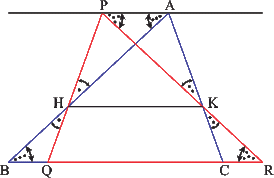Triangles and Circles
Statements Of Some Theorems On The Circle.
A straight line drawn from the centre of a circle to bisect a chord which is not a diameter, is at right angles to the chord.
MISSING IMAGE!
22109/pg_1.gif cannot be found in /users/22109/pg_1.gif. Please contact the submission author.
There is only one circle which passes through three given points which are not in a straight line.
Equal chords of a circle are equidistant from the centre and visa versa.
MISSING IMAGE!
22109/pg_2.gif cannot be found in /users/22109/pg_2.gif. Please contact the submission author.
The tangent to a circle and the radius through the point of contact are perpendicular to each other.
MISSING IMAGE!
13108/img_pg3.jpg cannot be found in /users/13108/img_pg3.jpg. Please contact the submission author.
The angle which an arc of a circle subtends at the centre is double that which it subtends at any point on the remaining part of the circumference.
MISSING IMAGE!
22109/pg_4.gif cannot be found in /users/22109/pg_4.gif. Please contact the submission author.
Angles in the same segment of a circle are equal.
MISSING IMAGE!
22109/pg_5.gif cannot be found in /users/22109/pg_5.gif. Please contact the submission author.
The angle in a semicircle is a right angle.
MISSING IMAGE!
22109/pg_5_1.gif cannot be found in /users/22109/pg_5_1.gif. Please contact the submission author.
The opposite angles of any quadrilateral inscribed in a circle are supplementary.
MISSING IMAGE!
22109/gm_10.gif cannot be found in /users/22109/gm_10.gif. Please contact the submission author.
If a straight line touches a circle and from the point of contact a chord is drawn, the angles which this tangent makes with the chord are equal to the angles in the alternate segment.
MISSING IMAGE!
22109/pg_7.gif cannot be found in /users/22109/pg_7.gif. Please contact the submission author.
Example - Supplementary
A line

Draw the line
Proof
from Theorem H above the points
Statements Of Some Theorems On Proportions And Similar Triangles.
If a straight line is drawn parallel to one side of a triangle, the other two sides are divided proportionally.
MISSING IMAGE!
22109/gm_11.gif cannot be found in /users/22109/gm_11.gif. Please contact the submission author.
If two triangles are equiangular their corresponding sides are proportional.
MISSING IMAGE!
22109/gm_12.gif cannot be found in /users/22109/gm_12.gif. Please contact the submission author.
If two triangles have one equal angle and the sides about these equal angles are proportional, then the triangles are similar.
MISSING IMAGE!
22109/gm_13.gif cannot be found in /users/22109/gm_13.gif. Please contact the submission author.
If a triangle is drawn from the right angle of a right angled triangle to the hypotenuse, then the triangles on each side of of the perpendicular are similar to the whole triangle and to one another.
MISSING IMAGE!
22109/gm_17.gif cannot be found in /users/22109/gm_17.gif. Please contact the submission author.
The internal bisector of an angle of a triangle divides the opposite side in the ratio of the sides containing the angle.
MISSING IMAGE!
22109/gm_18.gif cannot be found in /users/22109/gm_18.gif. Please contact the submission author.
Example - Example 1

It can be seen that
Pythagoras Theorem
MISSING IMAGE!
22109/gm_17_1.gif cannot be found in /users/22109/gm_17_1.gif. Please contact the submission author.
Given the right triangle
Draw
Proof
The triangles
Note
Two Theorems On Similar Rectilinear Figures.
MISSING IMAGE!
22109/gm_30.gif cannot be found in /users/22109/gm_30.gif. Please contact the submission author.
MISSING IMAGE!
22109/gm_32.gif cannot be found in /users/22109/gm_32.gif. Please contact the submission author.
Example - Similarities

 Login
Login

